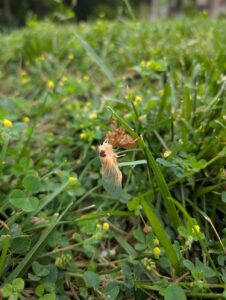This spring brought a level of tree damage I hadn’t seen in nearly two decades. It began with a low drone early in the day. By afternoon, the yard was filled with that steady, rhythmic sound—strong enough to feel in my chest. Then the cicadas arrived in large numbers: slow-flying, red-eyed insects landing on branches, screens, and anything in their path. What started as a natural phenomenon quickly turned into a serious threat for my bonsai collection and several deciduous yard trees.
At first, I didn’t worry. We get annual cicadas every summer—green and black, with clear wings. They buzz through August, do little harm, and vanish before you give them a second thought. They never lay eggs in bonsai, and I’ve never seen twig damage from them. But these weren’t annual cicadas. These were periodical cicadas, and they brought destruction I didn’t anticipate.
They didn’t feed on leaves or roots. Instead, they precisely targeted the very branches I’d spent years refining. On my largest Japanese maple bonsai, three of the most promising shoots were hit. Each one was just the right size—pencil-thick, full of potential—and in under a week, each was flagging or torn.
Brood XIX and Brood XIII: A Rare Overlap
In spring 2024, two major periodical cicada broods—Brood XIX (13-year) and Brood XIII (17-year)—emerged simultaneously. This co-emergence hadn’t occurred since 1803 and won’t happen again until 22451.
Brood XIII typically appears in northern Illinois, southern Wisconsin, and eastern Iowa, while Brood XIX emerges across much of Missouri, Kentucky, Tennessee, and surrounding regions. That overlap meant certain counties, especially in central Illinois, experienced cicada densities in the millions per acre, with multiple Magicicada species active at once.
The Real Damage Comes from Egg-Laying
Periodical cicadas don’t feed in the conventional sense. Their damage comes from female oviposition—cutting slits in pencil-thick twigs with an ovipositor, then depositing 20–30 eggs per slit. One female can lay hundreds of eggs over her lifespan, creating scars that interrupt vascular flow and cause branch tips to wilt and die—a process known as “flagging”2.
Why Bonsai Trees Are Especially Vulnerable
In bonsai, every shoot matters. The branches cicadas targeted were exactly the ones I’d been refining for years—the future apexes or structural extensions. Those shoots were a pencil in diameter, precisely what cicadas prefer for egg-laying3.
Across my garden, young Japanese maples took the heaviest hits. I lost three vital branches on one bonsai that had been wired and refined. Young Korean hornbeam, serviceberry, and stewartia in the yard also suffered—some branches died immediately, others lingered and had to be removed later.
Recognizing the Signs
Early signs are subtle—a drooping tip, slight leaf discoloration. Closer inspection often reveals Y- or V-shaped slits in the bark, sometimes several in sequence. These indicate oviposition. Some branches fall off, others die slowly. It’s best to prune these cleanly to avoid fungal issues or further dieback.
Physical Barriers: Using Shade Cloth and a Hoop House
With cicadas active and damage underway, chemical control offered no help. My best option was physical exclusion.
I had an existing hoop house and closed it off with 30% woven shade cloth. I secured the edges tightly to reduce entry—but the material allowed occasional intrusion and needed regular monitoring. Inside, cicada activity slowed; oviposition scars and flagging were noticeably reduced in comparison with exposed trees.
It wasn’t perfect—some cicadas entered during watering or when openings were left unsecured. But the difference in damage was clear. In the future, I’d upgrade to finer mesh—like row cover or insect netting—and focus on sealing all entry points.
Trees They Target Most
Studies confirm cicadas favor certain species. They include:
- Japanese maple (Acer palmatum)
- Red maple, silver maple
- Oak, elm, cherry, apple
- Hornbeam (Carpinus spp.)
Conifers are rarely affected unless they have long, thin shoots. I saw no damage on pines or junipers, but have heard of rare cases where new growth was targeted.
Chemical Control Isn’t Effective
Periodical cicadas aren’t effectively controlled with chemicals. Since they don’t feed on foliage or roots, systemic insecticides are futile, and broad contact sprays require impractical coverage and timing. Experts strongly recommend physical protection instead: fine mesh netting, screening, or individual tree caps.
Cicada Lifecycle: What Happens Next
After mating and egg-laying, adults die. Eggs hatch late summer, and nymphs burrow for another 13 or 17 years. While underground, they feed on roots but cause minimal harm in small numbers. The next emergence for Brood XIX is 2037; Brood XIII returns in 2041.
Recovery for Bonsai and Garden Trees
Once the emergence ends, focus on recovery:
- Apply light fertilizer and consistent irrigation
- Avoid heavy pruning for the remainder of the season—let trees invest in healing
- Monitor for back-budding and delay wiring or styling until buds mature
- Many trees produce new buds in late summer—even on damaged shoots—indicating recovery potential
A Reminder That We Grow with the Seasons
This emergence was a clear reminder that bonsai work happens within the broader context of nature. We control what we can—design, wiring, watering. But nature still has its say.
The cicadas came, mated, laid eggs, and left. They altered some of my trees, but not the narrative. New buds are forming, and I’m already planning a stronger protective enclosure before the next emergence. I won’t be caught unprepared in 2041.
Sources
- USDA Forest Service – “Here Come Cicadas! Brood XIII and XIX”
https://www.fs.usda.gov/about-agency/features/here-come-cicadas ↩︎ - University of Illinois Extension – “Cicadas”
https://extension.illinois.edu/insects/cicadas ↩︎ - NPR Illinois / University of Illinois Extension – “Protecting Your Plants from Cicadas”
https://www.nprillinois.org/health-harvest/2024-05-17/protecting-your-plants-from-cicadas ↩︎



